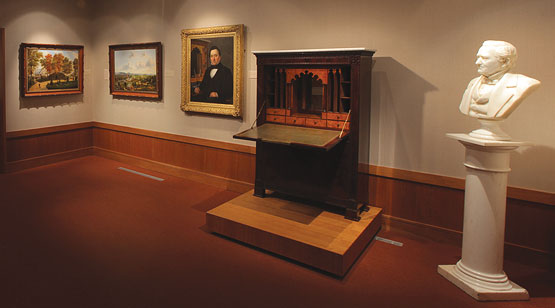Art & Vassar

When roof repairs forced the seven-month closure of the Frances Lehman Loeb Art Center—and the removal of all the art within—it presented a valuable opportunity to renovate and re-envision the galleries, a first since the César Pelli-designed Art Center opened in 1993.
The result is a new look and fresh organization as the recently reopened Art Center once again welcomes visitors to its impressive permanent collection and temporary exhibitions. The museum atrium now features Charles Loring Elliott’s eight-foot portrait of Matthew Vassar, commissioned by the trustees when the college was first chartered. Beyond the atrium, galleries showcase a selection of the college’s expansive collection of more than 18,000 works, including those of Cole, Durand, Church, Picasso, O’Keeffe, and Pollock.
While each work of art tells a piece of the Vassar story, curators have made the link more explicit in the new installation. For example, Alexander Calder’s Mobile with Black Particles is accompanied by a black-and-white photograph of Calder with former Vassar Art Gallery director and faculty member Agnes Rindge Claflin (who purchased the sculpture for the college), as the two stand side-by-side considering that very work. There’s also a painting by professor and artist C.K. Chatterton of how the collection appeared when installed in Taylor Hall.
The former Prints and Drawings galleries now invite visitors to explore the works from and related to the college’s founding collection, including many Hudson River School works, in a more intimate setting. The galleries include an early portrait of Matthew Vassar seated at his desk (displayed next to Mr. Vassar’s recently restored Duncan Phyfe desk), as well as a bust and portrait of Henry Van Ingen, the college’s first professor of art.
The Focus Gallery is a new addition to the Art Center. It presents short-term exhibitions of art not regularly on view in the other galleries, either as a complement to college coursework, or as an opportunity for the Art Center’s curators to explore various themes and topics.
Vassar courses are conducted in the galleries almost every day during the academic year. The Project Gallery continues to play an important role in class conversations. It is an un-curated space presenting works selected by the faculty from the college’s permanent collection, specifically for the purposes of student inquiry and research (often in conjunction with Art 105/106).
Such an educational component to the Art Center underscores its important role as a teaching museum. When Vassar College opened its doors, it became the first college chartered with an art gallery whose collection (initially composed of 3,000 works that Matthew Vassar purchased from trustee Elias Magoon) was directly tied to the curriculum of the institution. Originally known as the Vassar Art Gallery, it predated the Metropolitan Museum of Art in New York.
From the very beginning, it has existed as much more than a repository for great works of art. For 150 years, it has proven itself a central component of the Vassar education. That legacy continues, and the Art Center retains as much educational clout today as when Matthew Vassar first called for his nascent college for women to have an art gallery among its proud boasts.
